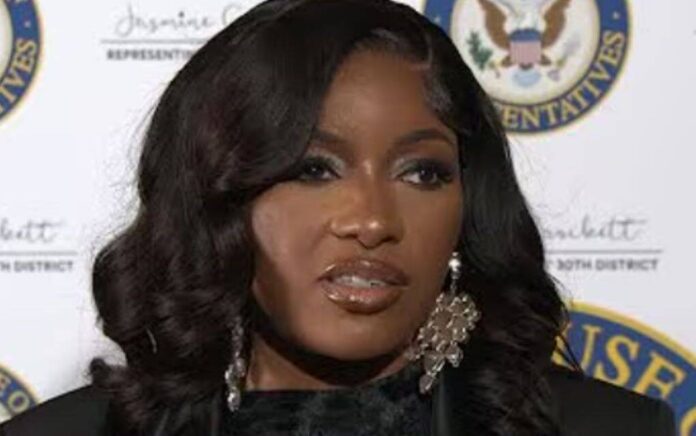
The radical Left simply can’t help themselves. They’re always putting themselves in an awful situation.
And this Democrat congresswoman had an aneurysm during a racist rant that’s left jaws on the floor.
In a candid moment during a recent podcast, Rep. Jasmine Crockett, D-Texas, peeled back the curtain on the Democratic Party’s early planning for the 2028 presidential race. Speaking on SiriusXM’s “Urban View” town hall, Crockett revealed that party donors are already rallying behind a single figure for the next election cycle—a candidate she described as the “safest white boy.” The comment, shared in a clip posted to Instagram by host Clay Cane on Friday, has sparked intrigue about the party’s direction.
Crockett’s remarks point to a cautious strategy taking shape among Democratic insiders. “It is this fear that the people within the party, within the primary system, will have about voting for a woman because every time we voted for a woman, we’ve lost, so far,” she said.
“And I think that that’s a natural fear because we just want to win.” Her words reflect a wary mindset among Democrats still stinging from past electoral defeats.
The Texas congresswoman was blunt about the influence of donors in shaping the party’s future. “No, for real. And to be clear, when we talk about them, I can tell you that there is one specific candidate,” she said. “I had a donor on the phone with me telling me that all the donors are lining up behind that candidate. So I can tell, and I tell you, it’s not a Black person, nor a woman, OK?”
Crockett’s use of “they” when referring to these donors suggests a continuity with the same power brokers who supported former President Biden, hinting at a preference for familiarity over change.
Names already circulating for the 2028 Democratic nomination include high-profile figures like California Gov. Gavin Newsom, Illinois Gov. JB Pritzker, Minnesota Gov. Tim Walz, former Transportation Secretary Pete Buttigieg, Rep. Alexandria Ocasio-Cortez, D-N.Y., and former Vice President Kamala Harris. Harris, despite her 2024 loss, remains a prominent figure, as evidenced by her headlining a major Democratic National Committee fundraising dinner last Tuesday. Her return to the spotlight signals she’s not ready to step back just yet.
Meanwhile, Crockett herself is making waves within the party. Reports from Semafor and Politico indicate she’s vying for the top Democratic spot on the House Oversight Committee, positioning herself as an opponent of the Trump agenda.
According to Politico, she’s reportedly told colleagues she is “made for the moment,” a nod to the party’s growing appetite for assertive resistance to the president’s influence. Known for her sharp and radical rhetoric, Crockett has emerged as a vocal figure in the Democratic pushback, capturing attention with her unapologetic style.
The Democratic Party’s early maneuvering for 2028 reveals a tension between ambition and caution. While some advocate for fresh, diverse voices to energize the base, others seem to favor a safer, more predictable path. Crockett’s comments suggest that, for now, the latter may hold sway as donors consolidate behind a candidate they believe can secure a win.
The Left’s Use of Race as a Divisive Tactic
Leftists like Crockett are constantly using race as a wedge to divide voters and create turmoil. Her comments about Democrats picking the “safest white boy,” are another example of her using race to cause an uproar.
The Left has increasingly leaned on racial identity as a political weapon, framing issues in ways that pit groups against one another. This tactic, often cloaked in the language of justice or equity, serves to fragment the electorate, ensuring loyalty from specific demographics while sowing distrust among others.
One clear example is the Left’s emphasis on racial grievances in political messaging. By amplifying narratives of systemic oppression, Democrats often cast entire groups—particularly white Americans—as inherently culpable, while positioning themselves as the sole defenders of marginalized communities.
This approach not only alienates potential allies but also deepens societal fractures, making coalition-building harder. It’s a strategy that thrives on division rather than unity, as it keeps voters focused on differences rather than shared goals.
Moreover, the Left’s selective outrage on racial issues often betrays a calculated agenda. Policies or incidents are framed as racist when they serve a political purpose, while similar issues are ignored if they don’t align with the narrative.
This inconsistency fuels cynicism among voters who see through the manipulation but feel powerless to counter it. By weaponizing race, the Left risks undermining genuine efforts at progress, turning complex issues into simplistic talking points designed to inflame rather than inform.
Ultimately, this divisive approach weakens the fabric of American society. Instead of fostering dialogue or mutual understanding, it encourages tribalism, where loyalty to one’s group supersedes the common good. As Democrats chart their path to 2028, they would do well to reconsider this tactic, recognizing that a united nation is stronger than one fractured by design.
Stay tuned to The Federalist Wire.



















